Ladder-like Poly(methacryloxypropyl) silsesquioxane-Al2O3-polybutadiene Flexible Nanocomposites with High Thermal Conductivity
Abstract
:1. Introduction
2. Results and Discussion
2.1. Ladder-like Polymethacryloxypropyl Silsesquioxane/Alumina Nanocomposites
Structural and Morphological Characterization
2.2. Polybutadiene/Ladder-like Polymethacryloxypropyl Silsesquioxane/Alumina Nanocomposites
Structural and Morphological Characterization
2.3. Thermal Conductivity of Nanocomposites
| Sample | TC (W m−1 K−1) | TC Gain (%) | Sample | TC (W m−1 K−1) | TC Gain (%) |
|---|---|---|---|---|---|
| L | 0.68 ± 0.05 | - | PB | 0.18 ± 0.01 | - |
| 10A_L | 0.72 ± 0.05 | +5.9% | PB_10L | 0.19 ± 0.01 | +5.5% |
| 20A_L | 0.85 ± 0.05 | +25% | PB/80AF_10L | 0.22 ± 0.01 | +15.8% |
| 40A_L | 1.11 ± 0.06 | +63.2% | PB/120AF_10L | 0.25 ± 0.01 | +31.6% |
| 10AF_L | 0.70 ± 0.05 | +2.9% | PB/205AF_10L | 0.28 ± 0.01 | +47.4% |
| 20AF_L | 0.79 ± 0.05 | +16.2% | PB_25L | 0.21 ± 0.01 | +16.6% |
| 40AF_L | 0.98 ± 0.06 | +44.1% | PB/512AF_25L | 0.42 ± 0.01 | +100.0% |
| 80AF_L | 1.22 ± 0.06 | +79.4% | PB_40L | 0.22 ± 0.01 | +22.2% |
| 120AF_L | 1.38 ± 0.06 | +102.9% | PB/512AF_40L | 0.39 ± 0.01 | +77.3% |
| - | - | - | PB/800AF_40L | 0.47 ± 0.01 | +113.6% |
3. Conclusions
4. Materials and Methods
4.1. Materials
4.2. Preparation of Samples
| Sample | Al2O3 Volume Fraction (vol%) |
|---|---|
| L | 0.0 |
| 10A_L | 3.0 |
| 20A_L | 5.7 |
| 40A_L | 10.6 |
| 10AF_L | 2.4 |
| 20AF_L | 5.8 |
| 40AF_L | 10.5 |
| 80AF_L | 19.1 |
| 120AF_L | 25.1 |
| Sample | LPMASQ (wt%) | Al2O3 Volume Fraction (vol%) |
|---|---|---|
| PB | 0.0 | 0.0 |
| PB_10L | 10.0 | 0.0 |
| PB/80AF_10L | 10.0 | 1.7 |
| PB/120AF_10L | 10.0 | 2.9 |
| PB/205AF_10L | 10.0 | 5.1 |
| PB_25L | 25.0 | 0.0 |
| PB/512AF_25L | 25.0 | 9.5 |
| PB_40L | 40.0 | 0.0 |
| PB/512AF_40L | 40.0 | 7.5 |
| PB/800AF_40L | 40.0 | 11.2 |
4.3. Characterization Techniques
4.4. Thermal Conductivity Modelling
- Linear mixture rule (parallel model) [49]: Equation (3). This model assumes uniform temperature gradient and heat flux as the weighted sum of heat fluxes through matrix and filler regions. The filler and matrix independently contribute to the thermal conductivity according to their relative volume fractions. The model is implicitly based on the assumption of perfect contact between particles.
- Inverse mixture rule (series model) [49]: Equation (4). This model assumes uniform heat flux and temperature gradient as the weighted sum of temperature gradients through matrix and filler regions. The series model is most applicable for fillers dispersed in a matrix without percolation, even at high filler loadings.
Supplementary Materials
Author Contributions
Funding
Institutional Review Board Statement
Informed Consent Statement
Data Availability Statement
Acknowledgments
Conflicts of Interest
References
- Dirè, S.; Borovin, E.; Ribot, F. Architecture of Silsesquioxanes. In Handbook of Sol-Gel Science and Technology; Klein, L., Aparicio, M., Jitianu, A., Eds.; Springer International Publishing: Cham, Switzerland, 2016; pp. 1–34. [Google Scholar]
- Choi, S.-S.; Lee, A.S.; Hwang, S.S.; Baek, K.-Y. Structural control of fully condensed polysilsesquioxanes: Ladderlike vs cage structured polyphenylsilsesquioxanes. Macromolecules 2015, 48, 6063–6070. [Google Scholar] [CrossRef]
- Zhou, H.; Ye, Q.; Xu, J. Polyhedral oligomeric silsesquioxane-based hybrid materials and their applications. Mater. Chem. Front. 2017, 1, 212–230. [Google Scholar] [CrossRef]
- Ayandele, E.; Sarkar, B.; Alexandridis, P. Polyhedral oligomeric silsesquioxane (POSS)-containing polymer nanocomposites. Nanomaterials 2012, 2, 445–475. [Google Scholar] [CrossRef] [PubMed]
- Raftopoulos, K.N.; Pielichowski, K. Segmental dynamics in hybrid polymer/POSS nanomaterials. Prog. Polym. Sci. 2016, 52, 136–187. [Google Scholar] [CrossRef]
- Kuo, S.-W. Building blocks precisely from polyhedral oligomeric silsesquioxane nanoparticles. ACS Cent. Sci. 2016, 2, 62–64. [Google Scholar] [CrossRef]
- Kuo, S.-W.; Chang, F.-C. POSS related polymer nanocomposites. Prog. Polym. Sci. 2011, 36, 1649–1696. [Google Scholar] [CrossRef]
- Fina, A.; Monticelli, O.; Camino, G. POSS-based hybrids by melt/reactive blending. J. Mater. Chem. 2010, 20, 9297–9305. [Google Scholar] [CrossRef]
- Tanaka, K.; Chujo, Y. Advanced functional materials based on polyhedral oligomeric silsesquioxane (POSS). J. Mater. Chem. 2012, 22, 1733–1746. [Google Scholar] [CrossRef]
- D’Arienzo, M.; Redaelli, M.; Callone, E.; Conzatti, L.; Di Credico, B.; Dirè, S.; Giannini, L.; Polizzi, S.; Schizzi, I.; Scotti, R.; et al. Hybrid SiO2@POSS nanofiller: A promising reinforcing system for rubber nanocomposites. Mater. Chem. Front. 2017, 1, 1441–1452. [Google Scholar] [CrossRef]
- Hao, N.; Böhning, M.; Goering, H.; Schönhals, A. Nanocomposites of polyhedral oligomeric phenethylsilsesquioxanes and poly(bisphenol A carbonate) as investigated by dielectric spectroscopy. Macromolecules 2007, 40, 2955–2964. [Google Scholar] [CrossRef]
- Bele, A.; Dascalu, M.; Tugui, C.; Iacob, M.; Racles, C.; Sacarescu, L.; Cazacu, M. Dielectric silicone elastomers filled with in situ generated polar silsesquioxanes: Preparation, characterization and evaluation of electromechanical performance. Mater. Des. 2016, 106, 454–462. [Google Scholar] [CrossRef]
- Raftopoulos, K.N.; Koutsoumpis, S.; Jancia, M.; Lewicki, J.P.; Kyriakos, K.; Mason, H.E.; Harley, S.J.; Hebda, E.; Papadakis, C.M.; Pielichowski, K.; et al. Reduced phase separation and slowing of dynamics in polyurethanes with three-dimensional POSS-based cross-linking moieties. Macromolecules 2015, 48, 1429–1441. [Google Scholar] [CrossRef]
- D’Arienzo, M.; Diré, S.; Masneri, V.; Rovera, D.; Di Credico, B.; Callone, E.; Mascotto, S.; Pegoretti, A.; Ziarelli, F.; Scotti, R. Tailoring the dielectric and mechanical properties of polybutadiene nanocomposites by using designed ladder-like polysilsesquioxanes. ACS Appl. Nano Mater. 2018, 1, 3817–3828. [Google Scholar] [CrossRef]
- Dirè, S.; Callone, E.; Ceccato, R.; Parrino, F.; Di Credico, B.; Mostoni, S.; Scotti, R.; D’Arienzo, M. Structural effects of TiO2 nanoparticles in photocurable ladder-like polysilsesquioxane nanocomposites. J. Sol-Gel Sci. Technol. 2023. [Google Scholar] [CrossRef]
- D’Arienzo, M.; Dirè, S.; Cobani, E.; Orsini, S.; Di Credico, B.; Antonini, C.; Callone, E.; Parrino, F.; Vacche, S.D.; Trusiano, G.; et al. SiO2/ladder-like polysilsesquioxanes nanocomposite coatings: Playing with the hybrid interface for tuning thermal properties and wettability. Coatings 2020, 10, 913. [Google Scholar] [CrossRef]
- Parrino, F.; D’Arienzo, M.; Callone, E.; Conta, R.; Di Credico, B.; Mascotto, S.; Meyer, A.; Scotti, R.; Dirè, S. TiO2 containing hybrid nanocomposites with active–passive oxygen scavenging capability. Chem. Eng. J. 2021, 417, 129135. [Google Scholar] [CrossRef]
- D’Arienzo, M.; Diré, S.; Redaelli, M.; Borovin, E.; Callone, E.; Di Credico, B.; Morazzoni, F.; Pegoretti, A.; Scotti, R. Unveiling the hybrid interface in polymer nanocomposites enclosing silsesquioxanes with tunable molecular structure: Spectroscopic, thermal and mechanical properties. J. Colloid Interface Sci. 2018, 512, 609–617. [Google Scholar] [CrossRef]
- Idumah, C.I.; Hassan, A. Recently emerging trends in thermal conductivity of polymer nanocomposites. Rev. Chem. Eng. 2016, 32, 413–457. [Google Scholar] [CrossRef]
- Moore, A.L.; Shi, L. Emerging challenges and materials for thermal management of electronics. Mater. Today 2014, 17, 163–174. [Google Scholar] [CrossRef]
- Xu, Y.; Kraemer, D.; Song, B.; Jiang, Z.; Zhou, J.; Loomis, J.; Wang, J.; Li, M.; Ghasemi, H.; Huang, X.; et al. Nanostructured polymer films with metal-like thermal conductivity. Nat. Commun. 2019, 10, 1771. [Google Scholar] [CrossRef]
- Dai, W.; Ma, T.; Yan, Q.; Gao, J.; Tan, X.; Lv, L.; Hou, H.; Wei, Q.; Yu, J.; Wu, J.; et al. Metal-level thermally conductive yet soft graphene thermal interface materials. ACS Nano 2019, 13, 11561–11571. [Google Scholar] [CrossRef]
- Suh, D.; Moon, C.M.; Kim, D.; Baik, S. Ultrahigh thermal conductivity of interface materials by silver-functionalized carbon nanotube phonon conduits. Adv. Mater. 2016, 28, 7220–7227. [Google Scholar] [CrossRef] [PubMed]
- Tong, X.C. (Ed.) Thermal management fundamentals and design guides in electronic packaging. In Advanced Materials for Thermal Management of Electronic Packaging; Springer: New York, NY, USA, 2011; pp. 1–58. [Google Scholar]
- Li, N.; Ren, J.; Wang, L.; Zhang, G.; Hänggi, P.; Li, B. Colloquium: Phononics: Manipulating heat flow with electronic analogs and beyond. Rev. Mod. Phys. 2012, 84, 1045–1066. [Google Scholar] [CrossRef]
- Ngo, I.-L.; Byon, C. A generalized correlation for predicting the thermal conductivity of composites with heterogeneous nanofillers. Int. J. Heat Mass Transf. 2015, 90, 894–899. [Google Scholar] [CrossRef]
- Huang, C.; Qian, X.; Yang, R. Thermal conductivity of polymers and polymer nanocomposites. Mater. Sci. Eng. R Rep. 2018, 132, 1–22. [Google Scholar] [CrossRef]
- Hansson, J.; Nilsson, T.M.J.; Ye, L.; Liu, J. Novel nanostructured thermal interface materials: A review. Int. Mater. Rev. 2018, 63, 22–45. [Google Scholar] [CrossRef]
- He, X.; Wang, Y. Recent advances in the rational design of thermal conductive polymer composites. Ind. Eng. Chem. Res. 2021, 60, 1137–1154. [Google Scholar] [CrossRef]
- Alamfard, T.; Lorenz, T.; Breitkopf, C. Thermal Conductivities of Uniform and Random Sulfur Crosslinking in Polybutadiene by Molecular Dynamic Simulation. Polymers 2023, 15, 2058. [Google Scholar] [CrossRef]
- Li, S.; Liu, B.; Jia, X.; Xu, M.; Zong, R.; Liu, G.; Huai, X. Optimization of Thermal Conductivity of Alumina-Filled Composites by Numerical Simulations. J. Therm. Sci. 2023, 32, 1569–1582. [Google Scholar] [CrossRef]
- Zhou, T.; Wang, X.; Mingyuan, G.U.; Liu, X. Study of the thermal conduction mechanism of nano-SiC/DGEBA/EMI-2,4 composites. Polymer 2008, 49, 4666–4672. [Google Scholar] [CrossRef]
- Shen, D.; Zhan, Z.; Liu, Z.; Cao, Y.; Zhou, L.; Liu, Y.; Dai, W.; Nishimura, K.; Li, C.; Lin, C.-T.; et al. Enhanced thermal conductivity of epoxy composites filled with silicon carbide nanowires. Sci. Rep. 2017, 7, 2606. [Google Scholar] [CrossRef] [PubMed]
- Rasouli, S.; Zabihi, A.; Fasihi, M.; Kharat, G.B.P. A Comprehensive Study on the Effect of Highly Thermally Conductive Fillers on Improving the Properties of SBR/BR-Filled Nano-Silicon Nitride. ACS Omega 2023, 8, 32701–32711. [Google Scholar] [CrossRef] [PubMed]
- Fang, H.; Li, G.; Wang, K.; Wu, F. Significant Improvement of Thermal Conductivity of Polyamide 6/Boron Nitride Composites by Adding a Small Amount of Stearic Acid. Polymers 2023, 15, 1887. [Google Scholar] [CrossRef] [PubMed]
- Fang, H.; Bai, S.-L.; Wong, C.P. “White graphene”–hexagonal boron nitride based polymeric composites and their application in thermal management. Compos. Commun. 2016, 2, 19–24. [Google Scholar] [CrossRef]
- Jiang, C.; Zhang, D.; Gan, X.; Xie, R.; Zhang, F.; Zhou, K. Preparation of high performance AlN/Hydantion composite by gelcasting and infiltration processes. Ceram. Int. 2014, 40, 2535–2538. [Google Scholar] [CrossRef]
- Ma, A.; Chen, W.; Hou, Y.; Zhang, G. The preparation and cure kinetics researches of thermal conductivity epoxy/AlN composites. Polym. Plast. Technol. Eng. 2010, 49, 354–358. [Google Scholar] [CrossRef]
- Mu, Q.; Feng, S.; Diao, G. Thermal conductivity of silicone rubber filled with ZnO. Polym. Compos. 2007, 28, 125–130. [Google Scholar] [CrossRef]
- Du, H.; Qi, Y.; Yu, W.; Yin, J.; Xie, H. T-shape ZnO whisker: A more effective thermal conductive filler than spherical particles for the thermal grease. Int. J. Heat Mass Transf. 2017, 112, 1052–1056. [Google Scholar] [CrossRef]
- Yorifuji, D.; Ando, S. Enhanced thermal conductivity over percolation threshold in polyimide blend films containing ZnO nano-pyramidal particles: Advantage of vertical double percolation structure. J. Mater. Chem. 2011, 21, 4402–4407. [Google Scholar] [CrossRef]
- Hu, Y.; Du, G.; Chen, N. A novel approach for Al2O3/epoxy composites with high strength and thermal conductivity. Compos. Sci. Technol. 2016, 124, 36–43. [Google Scholar] [CrossRef]
- Yao, Y.; Zeng, X.; Guo, K.; Sun, R.; Xu, J.-b. The effect of interfacial state on the thermal conductivity of functionalized Al2O3 filled glass fibers reinforced polymer composites. Compos. Part A Appl. Sci. Manuf. 2015, 69, 49–55. [Google Scholar] [CrossRef]
- Mirizzi, L.; D’Arienzo, M.; Nisticò, R.; Fredi, G.; Diré, S.; Callone, E.; Dorigato, A.; Giannini, L.; Guerra, S.; Mostoni, S.; et al. Al2O3 decorated with polyhedral silsesquioxane units: An unconventional filler system for upgrading thermal conductivity and mechanical properties of rubber composites. Compos. Sci. Technol. 2023, 236, 109977. [Google Scholar] [CrossRef]
- Mirizzi, L.; Carnevale, M.; D’Arienzo, M.; Milanese, C.; Di Credico, B.; Mostoni, S.; Scotti, R. Tailoring the thermal conductivity of rubber nanocomposites by inorganic systems: Opportunities and challenges for their application in tires formulation. Molecules 2021, 26, 3555. [Google Scholar] [CrossRef]
- Guo, B.; Tang, Z.; Zhang, L. Transport performance in novel elastomer nanocomposites: Mechanism, design and control. Prog. Polym. Sci. 2016, 61, 29–66. [Google Scholar] [CrossRef]
- Cheng, J.P.; Liu, T.; Zhang, J.; Wang, B.B.; Ying, J.; Liu, F.; Zhang, X.B. Influence of phase and morphology on thermal conductivity of alumina particle/silicone rubber composites. Appl. Phys. A 2014, 117, 1985–1992. [Google Scholar] [CrossRef]
- Zhou, W.; Qi, S.; Tu, C.; Zhao, H.; Wang, C.; Kou, J. Effect of the particle size of Al2O3 on the properties of filled heat-conductive silicone rubber. J. Appl. Polym. Sci. 2007, 104, 1312–1318. [Google Scholar] [CrossRef]
- Chen, H.; Ginzburg, V.V.; Yang, J.; Yang, Y.; Liu, W.; Huang, Y.; Du, L.; Chen, B. Thermal conductivity of polymer-based composites: Fundamentals and applications. Prog. Polym. Sci. 2016, 59, 41–85. [Google Scholar] [CrossRef]
- Burger, N.; Laachachi, A.; Ferriol, M.; Lutz, M.; Toniazzo, V.; Ruch, D. Review of thermal conductivity in composites: Mechanisms, parameters and theory. Prog. Polym. Sci. 2016, 61, 1–28. [Google Scholar] [CrossRef]
- Mehra, N.; Mu, L.; Ji, T.; Yang, X.; Kong, J.; Gu, J.; Zhu, J. Thermal transport in polymeric materials and across composite interfaces. Appl. Mater. Today 2018, 12, 92–130. [Google Scholar] [CrossRef]
- Wang, Y.; Zhan, H.F.; Xiang, Y.; Yang, C.; Wang, C.M.; Zhang, Y.Y. Effect of covalent functionalization on thermal transport across graphene–polymer interfaces. J. Phys. Chem. C 2015, 119, 12731–12738. [Google Scholar] [CrossRef]
- Yao, Y.; Zeng, X.; Pan, G.; Sun, J.; Hu, J.; Huang, Y.; Sun, R.; Xu, J.-B.; Wong, C.-P. Interfacial engineering of silicon carbide nanowire/cellulose microcrystal paper toward high thermal conductivity. ACS Appl. Mater. Interfaces 2016, 8, 31248–31255. [Google Scholar] [CrossRef] [PubMed]
- Mu, L.; Shi, Y.; Guo, X.; Wu, J.; Ji, T.; Chen, L.; Feng, X.; Lu, X.; Hua, J.; Zhu, J. Enriching heteroelements in lignin as lubricating additives for bioionic liquids. ACS Sustain. Chem. Eng. 2016, 4, 3877–3887. [Google Scholar] [CrossRef]
- Rashidi, V.; Coyle, E.J.; Sebeck, K.; Kieffer, J.A.-O.; Pipe, K.A.-O. Thermal conductance in cross-linked polymers: Effects of non-bonding interactions. J. Phys. Chem. B 2017, 121, 4600–4609. [Google Scholar] [CrossRef] [PubMed]
- Kodama, T.; Shinohara, N.; Hung, S.-W.; Xu, B.; Obori, M.; Suh, D.; Shiomi, J. Modulation of interfacial thermal transport between fumed silica nanoparticles by surface chemical functionalization for advanced thermal insulation. ACS Appl. Mater. Interfaces 2021, 13, 17404–17411. [Google Scholar] [CrossRef] [PubMed]
- Chang, B.S.; Li, C.; Dai, J.; Evans, K.; Huang, J.; He, M.; Hu, W.; Tian, Z.; Xu, T. Thermal percolation in well-defined nanocomposite thin films. ACS Appl. Mater. Interfaces 2022, 14, 14579–14587. [Google Scholar] [CrossRef]
- Cao, J.-P.; Zhao, J.; Zhao, X.; You, F.; Yu, H.; Hu, G.-H.; Dang, Z.-M. High thermal conductivity and high electrical resistivity of poly(vinylidene fluoride)/polystyrene blends by controlling the localization of hybrid fillers. Compos. Sci. Technol. 2013, 89, 142–148. [Google Scholar] [CrossRef]
- Zhang, D.-L.; Zha, J.-W.; Li, C.-Q.; Li, W.-K.; Wang, S.-J.; Wen, Y.; Dang, Z.-M. High thermal conductivity and excellent electrical insulation performance in double-percolated three-phase polymer nanocomposites. Compos. Sci. Technol. 2017, 144, 36–42. [Google Scholar] [CrossRef]
- Choi, S.S.; Lee, A.S.; Lee, H.S.; Jeon, H.Y.; Baek, K.Y.; Choi, D.H.; Hwang, S.S. Synthesis and characterization of UV-curable ladder-like polysilsesquioxane. J. Polym. Sci. Part A Polym. Chem. 2011, 49, 5012–5018. [Google Scholar] [CrossRef]
- Soo Lee, A.S.; Lee, J.H.; Lee, J.-C.; Hong, S.M.; Hwang, S.S.; Koo, C.M. Novel polysilsesquioxane hybrid polymer electrolytes for lithium ion batteries. J. Mater. Chem. A 2014, 2, 1277–1283. [Google Scholar] [CrossRef]
- McCreedy, K.; Keskkula, H. Effect of thermal crosslinking on decomposition of polybutadiene. Polymer 1979, 20, 1155–1159. [Google Scholar] [CrossRef]
- Li, J.; Zhang, X.; Yuen, M.M.F.; Liu, L.; Ku, C.S.; Zhang, K. Enhancing the thermal conductivity of silicone composites by increasing crosslink degree. In Proceedings of the 2014 15th International Conference on Electronic Packaging Technology, Chengdu, China, 12–15 August 2014; pp. 329–333. [Google Scholar]
- Huda, N.; Whitney, M.A.; Razmpoosh, M.H.; Gerlich, A.P.; Wen, J.Z.; Corbin, S.F. How phase (α and γ) and porosity affect specific heat capacity and thermal conductivity of thermal storage alumina. J. Am. Ceram. Soc. 2021, 104, 1436–1447. [Google Scholar] [CrossRef]
- Ouyang, Y.; Li, X.; Ding, F.; Bai, L.; Yuan, F. Simultaneously enhance thermal conductive property and mechanical properties of silicon rubber composites by introducing ultrafine Al2O3 nanospheres prepared via thermal plasma. Compos. Sci. Technol. 2020, 190, 108019. [Google Scholar] [CrossRef]
- Gao, B.Z.; Xu, J.Z.; Peng, J.J.; Kang, F.Y.; Du, H.D.; Li, J.; Chiang, S.W.; Xu, C.J.; Hu, N.; Ning, X.S. Experimental and theoretical studies of effective thermal conductivity of composites made of silicone rubber and Al2O3 particles. Thermochim. Acta 2015, 614, 1–8. [Google Scholar] [CrossRef]
- Zamperlin, N.; Bottacini, A.; Callone, E.; Pegoretti, A.; Fontana, M. Barium titanate functionalization with organosilanes: Effect on particle compatibility and permittivity in nanocomposites. Molecules 2022, 27, 6499. [Google Scholar] [CrossRef] [PubMed]
- Rivière, L.; Lonjon, A.; Dantras, E.; Lacabanne, C.; Olivier, P.; Gleizes, N.R. Silver fillers aspect ratio influence on electrical and thermal conductivity in PEEK/Ag nanocomposites. Eur. Polym. J. 2016, 85, 115–125. [Google Scholar] [CrossRef]
- Pietrak, K.; Wiśniewski, T.S. A review of models for effective thermal conductivity of composite materials. J. Power Technol. 2014, 95, 14–24. [Google Scholar]
- Hussain, A.R.J.; Alahyari, A.A.; Eastman, S.A.; Thibaud-Erkey, C.; Johnston, S.; Sobkowicz, M.J. Review of polymers for heat exchanger applications: Factors concerning thermal conductivity. Appl. Therm. Eng. 2017, 113, 1118–1127. [Google Scholar] [CrossRef]
- Tavangar, R.; Molina, J.M.; Weber, L. Assessing predictive schemes for thermal conductivity against diamond-reinforced silver matrix composites at intermediate phase contrast. Scr. Mater. 2007, 56, 357–360. [Google Scholar] [CrossRef]

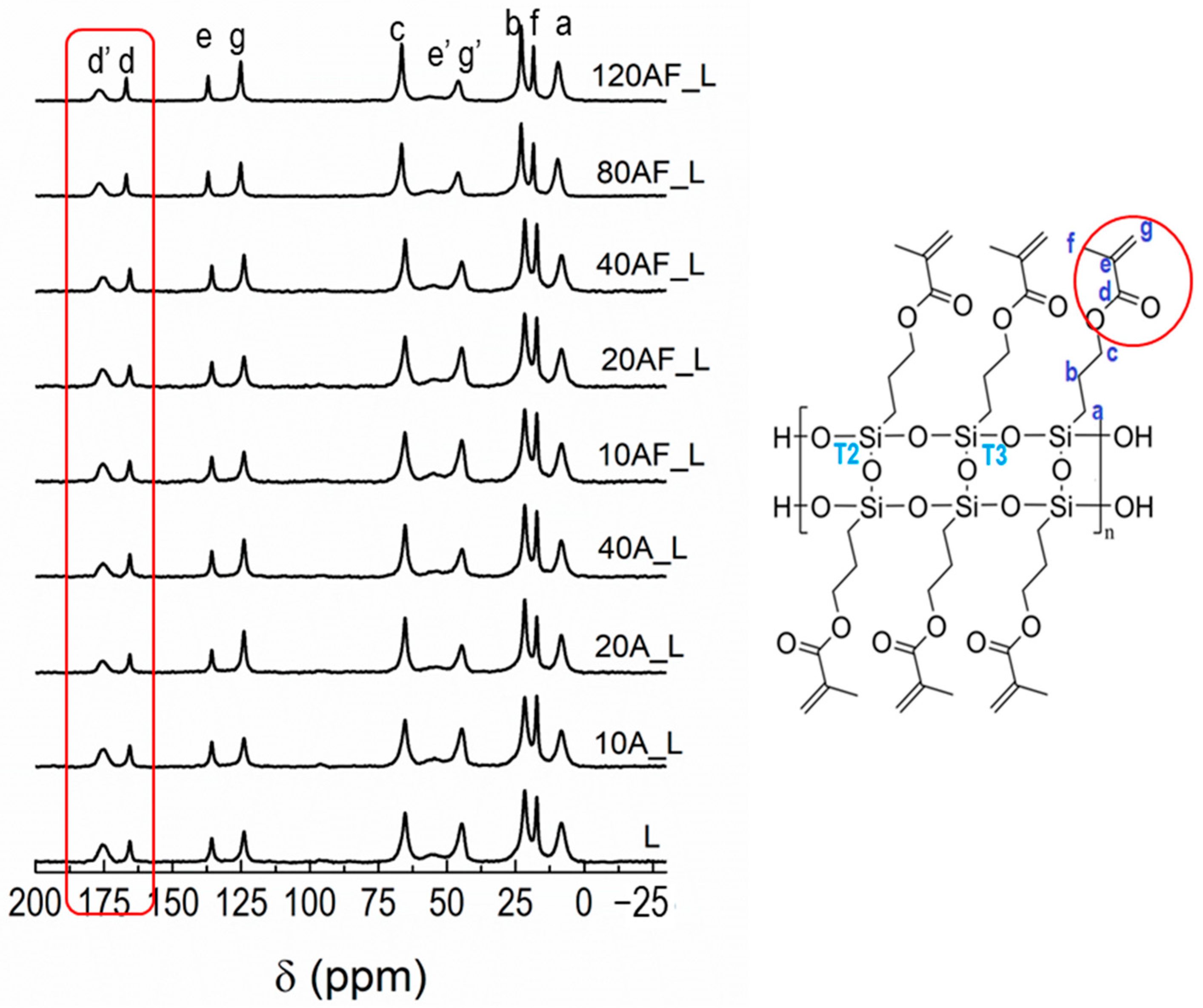
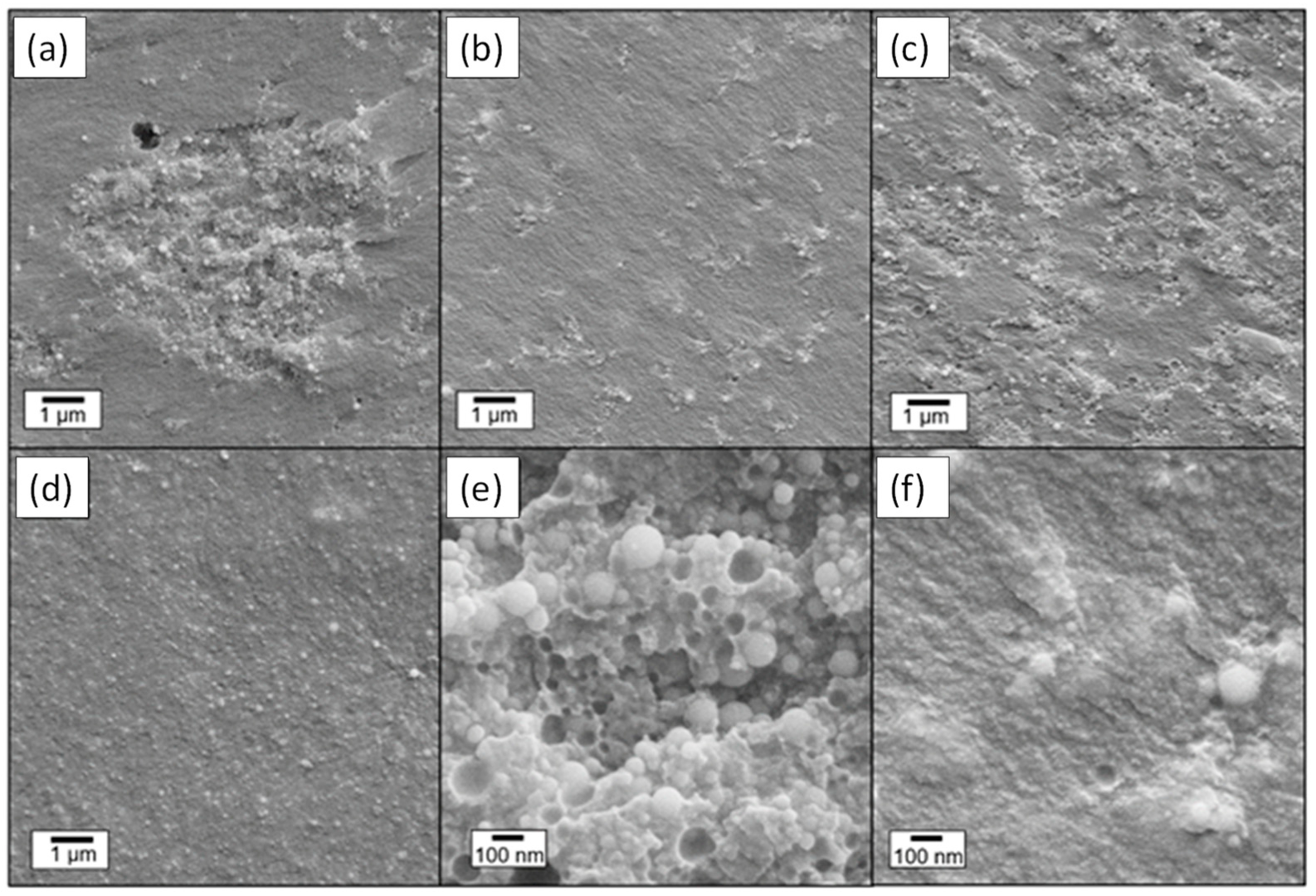

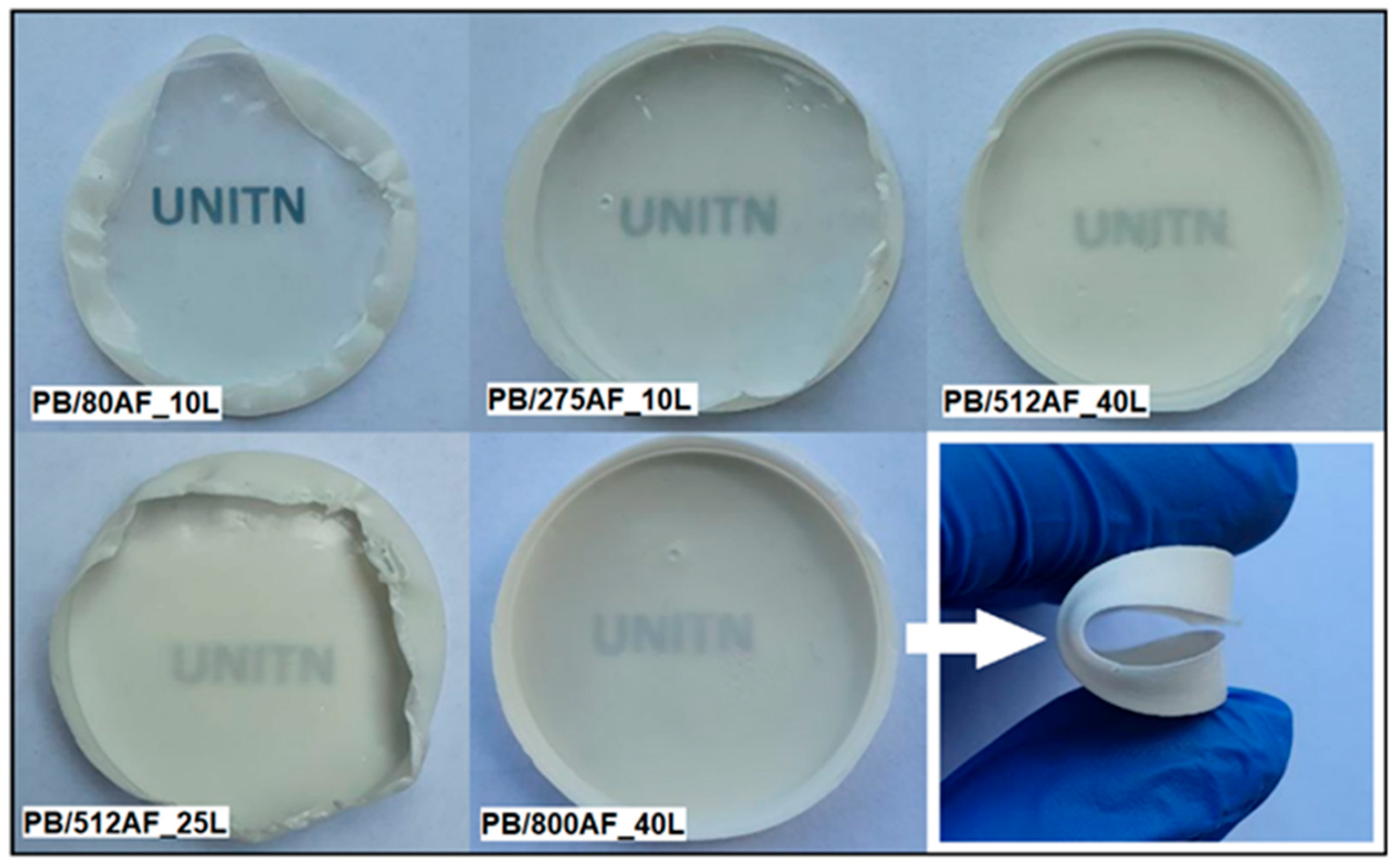
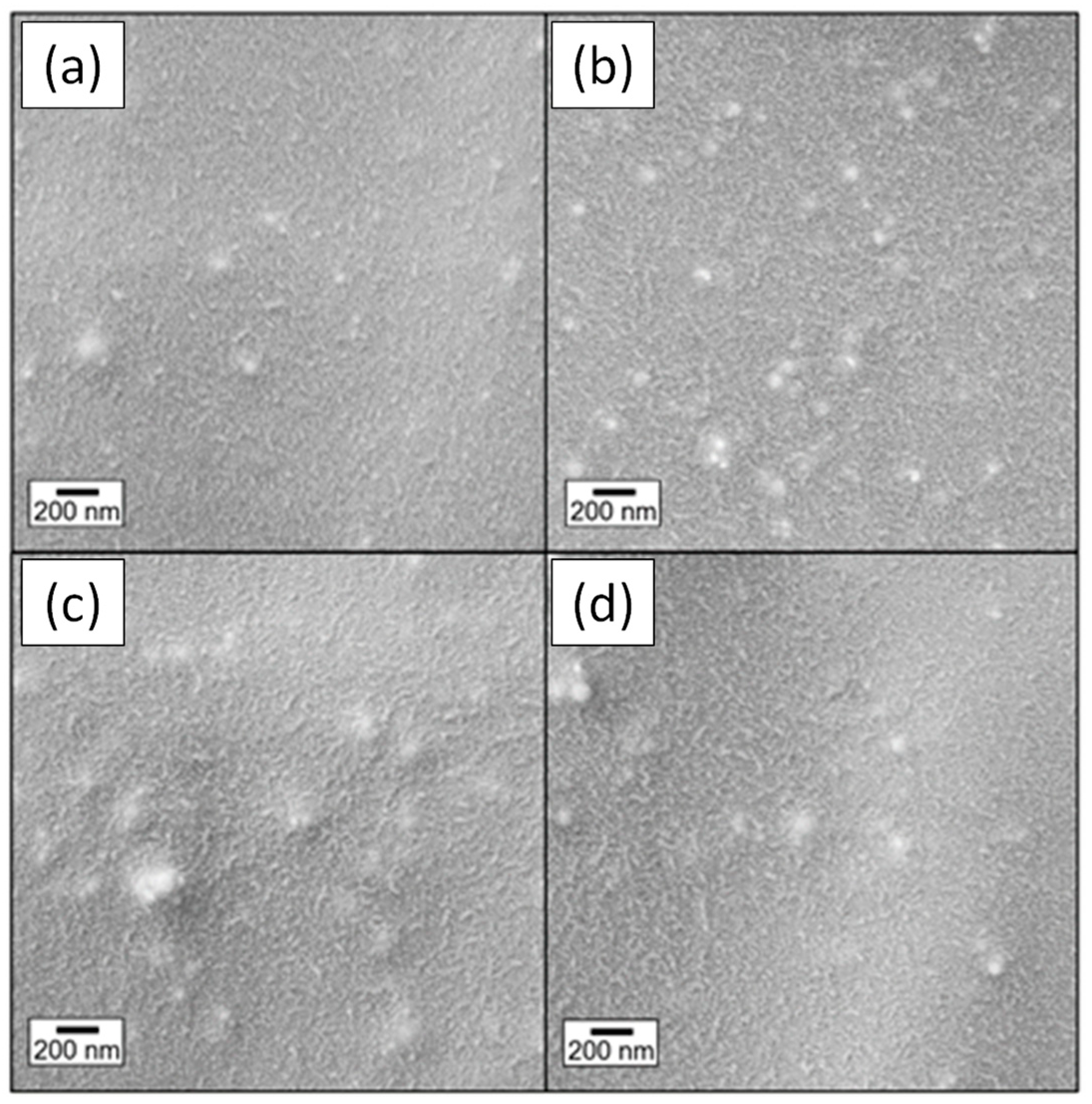
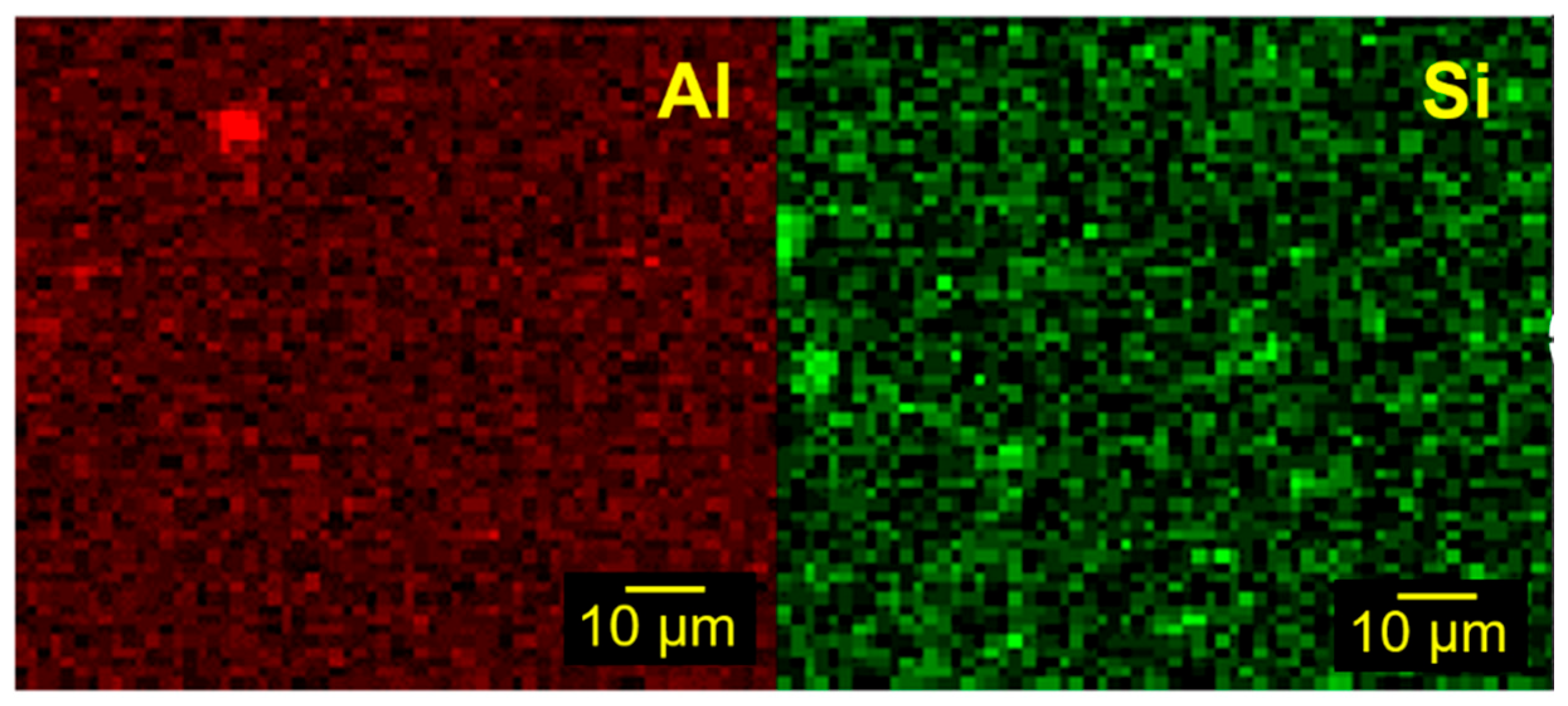
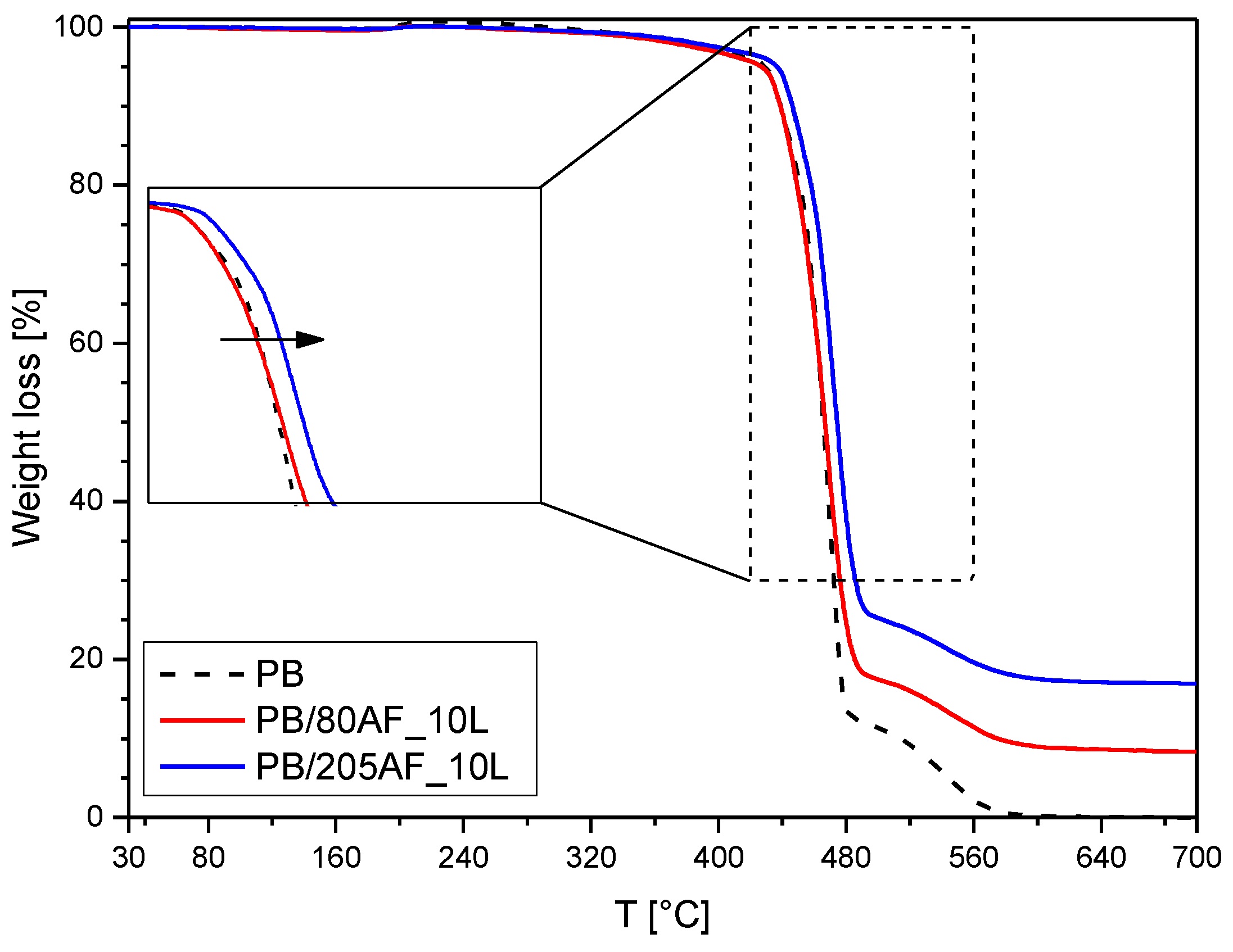



Disclaimer/Publisher’s Note: The statements, opinions and data contained in all publications are solely those of the individual author(s) and contributor(s) and not of MDPI and/or the editor(s). MDPI and/or the editor(s) disclaim responsibility for any injury to people or property resulting from any ideas, methods, instructions or products referred to in the content. |
© 2023 by the authors. Licensee MDPI, Basel, Switzerland. This article is an open access article distributed under the terms and conditions of the Creative Commons Attribution (CC BY) license (https://creativecommons.org/licenses/by/4.0/).
Share and Cite
Mingarelli, P.; Romeo, C.; Callone, E.; Fredi, G.; Dorigato, A.; D’Arienzo, M.; Parrino, F.; Dirè, S. Ladder-like Poly(methacryloxypropyl) silsesquioxane-Al2O3-polybutadiene Flexible Nanocomposites with High Thermal Conductivity. Gels 2023, 9, 810. https://doi.org/10.3390/gels9100810
Mingarelli P, Romeo C, Callone E, Fredi G, Dorigato A, D’Arienzo M, Parrino F, Dirè S. Ladder-like Poly(methacryloxypropyl) silsesquioxane-Al2O3-polybutadiene Flexible Nanocomposites with High Thermal Conductivity. Gels. 2023; 9(10):810. https://doi.org/10.3390/gels9100810
Chicago/Turabian StyleMingarelli, Pietro, Chiara Romeo, Emanuela Callone, Giulia Fredi, Andrea Dorigato, Massimiliano D’Arienzo, Francesco Parrino, and Sandra Dirè. 2023. "Ladder-like Poly(methacryloxypropyl) silsesquioxane-Al2O3-polybutadiene Flexible Nanocomposites with High Thermal Conductivity" Gels 9, no. 10: 810. https://doi.org/10.3390/gels9100810











